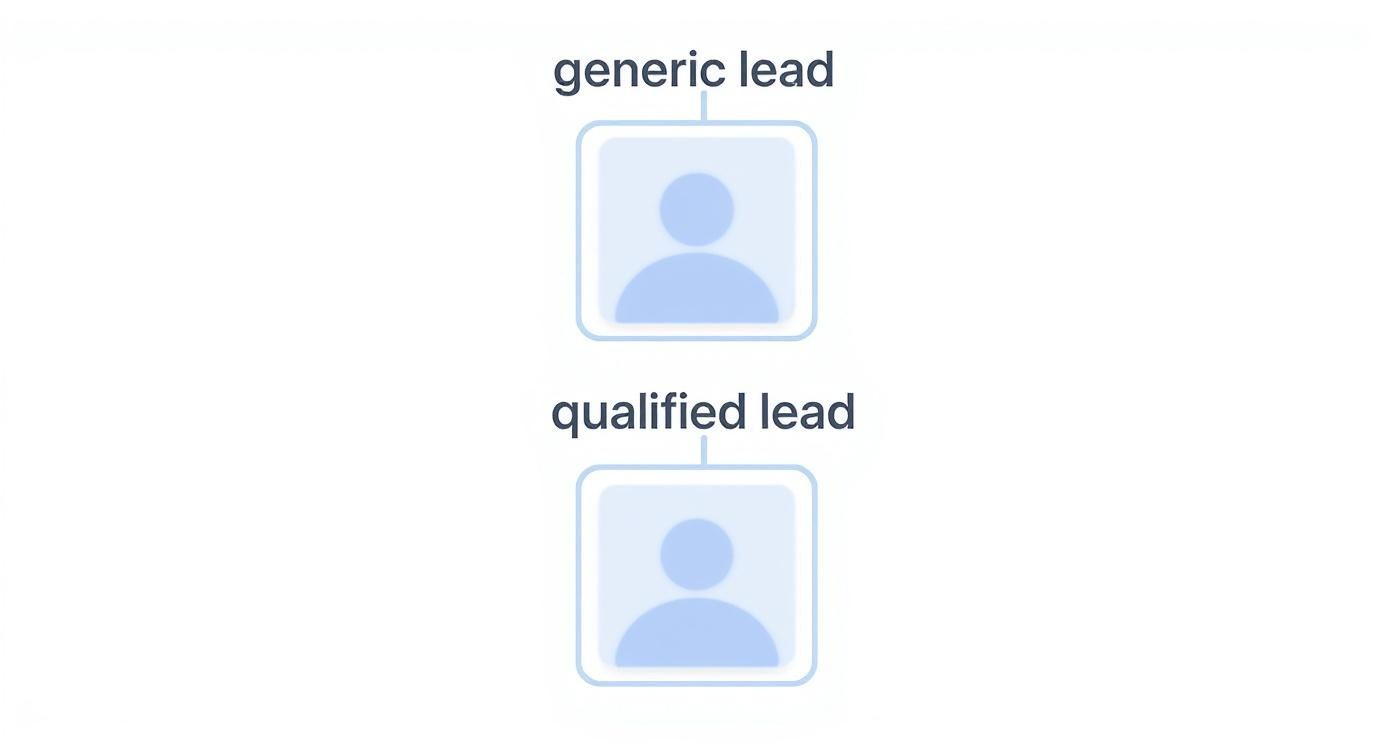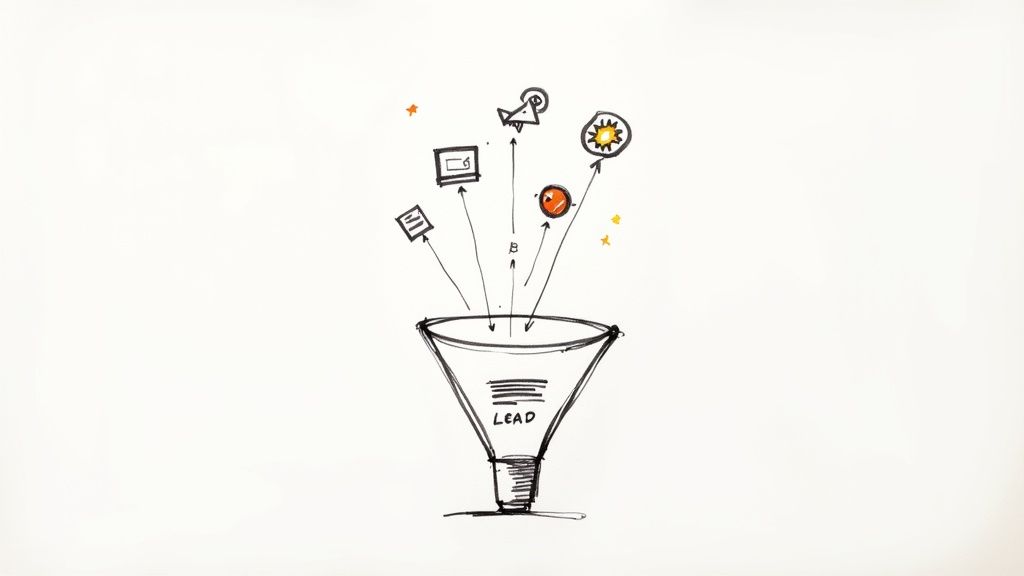Think of a sales lead description as a detailed, actionable profile of a potential customer. It's more than just a name and an email address; it’s a living document that captures their needs, their behaviors, and how close they are to making a purchase. It basically turns a faceless contact into a real person, giving your sales team a clear roadmap for how to approach them.
Why Your Sales Lead Description Is Your Most Valuable Asset
Imagine getting a lead that's just a name and a company. It's like a blurry photo—you can see the basic shape, but all the important details are missing. A great sales lead description, on the other hand, is like a high-definition portrait. It shows you exactly who they are, what problem they’re trying to solve, and how you fit into that picture.
This kind of clarity isn't just a nice-to-have; it's a strategic weapon. A well-written description allows your team to instantly spot the high-potential leads, tailor their pitch perfectly, and stop wasting time chasing ghosts. It’s the starting block for every single sale you'll ever make.
A detailed description transforms lead generation from a random numbers game into a focused, strategic process. It’s all about pursuing quality over quantity, making sure every conversation is intentional and drives the relationship forward.
Unfortunately, most businesses are terrible at converting the leads they bring in. When you realize that only about 2.9% of leads ever become customers, and the average cost to acquire a single lead is $198.44, the picture gets a little grim.
This is exactly why a sharp sales lead description is so critical. It helps you zero in on the prospects who are actually a good fit, so you stop burning cash and effort on opportunities that were never going to close. You can read more about lead generation statistics and see how to fine-tune your own strategy.
By shifting from a vague contact to a detailed story, you hand your sales team a game-changing asset. This isn’t just about filling out fields in a CRM; it’s about laying the strategic foundation for reliable, predictable growth.
The Anatomy of a High-Impact Sales Lead
A truly powerful sales lead is so much more than just a name and an email address. It's a complete profile that tells a story, turning a cold contact into a warm opportunity. Think of it like a detective building a case file; each piece of data adds another layer of understanding, revealing the full picture of your potential customer.
To build this profile, you need to collect information across four key layers. Each one gives your sales team a different angle, allowing them to stop selling blindly and start connecting with prospects in a way that actually resonates.
This visual really drives home the difference between a generic contact and a lead that's been properly fleshed out.

As you can see, layering this data takes a blurry, unknown person and brings them into sharp focus as someone you can genuinely help.
The Four Layers of Lead Data
The first two layers are the foundation—the basic context of who the person is and where they work.
-
Demographics: This is the essential "who" information. We're talking about their name, job title, and location. For a home services business, for example, this could be a homeowner living in a specific zip code.
-
Firmographics: This is the "where" data, all about their company. You'll want to know the industry, company size, annual revenue, and maybe even the specific technology they’re already using.
These details are just the starting point, though. The real magic happens when you dig into their actions and motivations. The next two layers uncover the "what" and "why" behind their interest, which is the fuel for a truly effective sales conversation.
A great sales lead description doesn't just list facts; it connects the dots between a person's role, their company's challenges, and their recent behaviors to reveal a clear path to a sale.
Uncovering Intent and Motivation
This is where you graduate from basic facts to actionable intelligence.
-
Behavioral Data: This layer tracks "what" the lead has actually done. Did they visit certain pages on your website? Open a specific email? Download a guide on "choosing a new roofer" or attend one of your webinars? These actions are breadcrumbs that signal their current level of interest.
-
Psychographics: This reveals "why" they might care about what you offer. It gets into their goals, professional pain points, and motivations. A facility manager, for instance, might be driven by an urgent need to cut operational costs—a problem your service is perfectly positioned to solve.
From Cold Interest to a Sales-Ready Conversation

Here’s a hard truth: not all leads are created equal. Treating every potential customer the same is one of the fastest ways to waste time and lose deals. The key is understanding exactly where someone is on their path to making a purchase so you can create a sales lead description that truly reflects their intent.
Think about it like someone walking into a store. Some people are just browsing, checking things out. Others came in with a specific item in mind and are ready to talk to a salesperson. Your process has to know the difference.
The Three Stages of Lead Readiness
We can usually group leads into three distinct stages. Each one signals a different level of interest and requires a completely different approach from your team.
-
Information Qualified Lead (IQL): This is your "window shopper." They're at the very beginning of their journey, just starting to research a problem. They might download an ebook or read a blog post—that’s it. They're curious, but nowhere near ready to buy.
-
Marketing Qualified Lead (MQL): This person has stepped inside the store and is starting to look around with more purpose. They show deeper interest by coming back to your site, signing up for a webinar, or asking for a case study. They're actively checking out solutions, making them a perfect fit for your marketing team to nurture.
-
Sales Qualified Lead (SQL): This is the person walking up to the counter, wallet in hand. An SQL has taken a big step that signals they’re ready to talk business, like requesting a demo or asking for a price quote. These are the leads your sales team needs to jump on right away.
To help your team get on the same page, a simple comparison can make all the difference.
Comparing Lead Qualification Stages
| Lead Type | Primary Characteristic | Typical Action | Next Step |
|---|---|---|---|
| IQL | Problem-Aware | Downloads an ebook, reads a blog post | Add to an email nurture sequence |
| MQL | Solution-Aware | Attends a webinar, requests a case study | Targeted marketing campaigns, more content |
| SQL | Purchase-Ready | Asks for a demo or a price quote | Immediate follow-up from a sales rep |
Having these clear definitions prevents your team from making a sales pitch way too early, which almost always scares off someone who's just looking for information.
Key Takeaway: The whole point of distinguishing between lead types is to focus your resources effectively. Marketing nurtures the IQLs and MQLs, while sales invests their valuable time closing deals with the SQLs who are genuinely ready to buy.
It’s all about meeting people where they are. This simple discipline ensures you’re not wasting energy on conversations that aren't ready to happen yet and are maximizing your chances with those that are.
Practical Frameworks for Qualifying Your Leads
It’s one thing to know you need to qualify leads, but it's a whole other challenge to do it consistently. Without a structured approach, those first calls can feel more like random interrogations, and your sales lead description ends up as a jumbled mess of notes. That’s where proven frameworks come in—they give you a reliable roadmap for these conversations.
Think of these frameworks less as a rigid script and more as a guide for a productive conversation. They ensure you’re asking the right questions to uncover the details that matter. This helps your team transform a simple contact into a deeply understood opportunity, all while building a solid relationship instead of just ticking boxes.
The BANT Framework Explained
One of the oldest and most straightforward frameworks out there is BANT. It’s been around for a long time for a simple reason: it works. The goal of BANT is to quickly figure out if a lead has the essentials of a real prospect by focusing on four key areas.
- Budget: Does the prospect have the money to actually buy what you're selling? A simple way to broach this is, "Have you set aside a budget for tackling this challenge?"
- Authority: Are you talking to the person who can actually sign off on the deal? You can ask, "Who else on your team will be involved in looking at this solution?"
- Need: Do they have a real business problem that your product can solve? Try digging in with, "What are the biggest headaches you're currently dealing with in this area?"
- Timeline: Do they have a specific timeframe in mind for getting this problem solved? A direct question like, "When are you hoping to have a new solution up and running?" gets right to the point.
Using BANT helps you run a quick, foundational check before your sales team sinks too much time and energy into a dead end. It gives you a solid baseline for your lead description, confirming that the opportunity is worth pursuing. If you're using a specific CRM, resources like this Hubspot Lead Scoring Guide can offer practical steps for integrating these frameworks directly into your system.
When you use a framework, you shift from a reactive Q&A to a proactive discovery process. You guide the conversation, uncovering the details you need to build a compelling and accurate sales lead description that sets your entire team up for success.
How Lead Source Shapes Your Sales Approach

Knowing where a lead came from is just as important as knowing who they are. The source gives you a ton of context about their mindset and what they're looking for, which should directly shape your entire sales approach from the first hello.
Think about it. A lead you met at a busy trade show is worlds apart from someone who filled out the "Contact Us" form on your website. The trade show attendee was likely just browsing, maybe grabbing some free swag. The website visitor, on the other hand, is actively looking for a solution. You can't treat them the same.
It's all about reading the digital body language. A prospect who downloads a deep-dive technical whitepaper is probably in the early research phase. They'll respond best to a softer, more educational follow-up. But someone who clicks a targeted social media ad and immediately requests a demo? That’s a signal of much stronger, immediate intent.
Adapting to Digital Channels
Digital channels are a goldmine for this kind of context. Social media, in particular, has become a major player in the B2B space. In fact, 40% of B2B marketers point to LinkedIn as their most effective channel for generating quality leads.
A lead from a LinkedIn Lead Gen Form, which can see conversion rates as high as 13%, is almost always going to be warmer than a name on a cold-call list. You can find more stats on lead generation trends over at Emailvendorselection.com.
Pro Tip: Always, always note the original source in your lead description. This single piece of data dictates the tone, urgency, and focus of your conversation. It helps you meet the prospect exactly where they are in their journey.
Tracking the source is also the backbone of figuring out how to measure marketing ROI, as it’s the only way to connect specific campaigns to real sales opportunities.
This context gives you the perfect opening line. Instead of a generic pitch, you can say something instantly relevant like, "I saw you downloaded our guide on X…" This little bit of personalization builds immediate rapport and shows you've done your homework, which can make all the difference.
Common Questions About Sales Leads
As you start dialing in your lead management process, you'll find the same questions tend to surface over and over. Getting everyone on the same page with clear, straightforward answers is key to making sure your system actually works. Let's tackle some of the most common ones.
What Is the Difference Between a Lead and a Prospect?
Think of it like panning for gold. A lead is like a shovelful of dirt from the riverbed—it might contain gold. It’s anyone who has shown some kind of initial interest, even if it's passive. Maybe they dropped a business card at a trade show or downloaded a free guide. At this point, you don't really know much about them.
A prospect is what's left after you've washed away the dirt and found a nugget. This is a lead you’ve actively qualified. You've confirmed they match your ideal customer profile, have a real problem you can fix, and probably have the authority to make a buying decision. A prospect isn't just a name; it's a genuine sales opportunity.
The journey from lead to prospect is where the real work of qualification happens. It’s how you separate the window shoppers from the serious buyers, so your sales team can focus their energy where it will actually pay off.
How Does CRM Software Help with Sales Lead Descriptions?
Your Customer Relationship Management (CRM) software is mission control for all your lead information. It’s so much more than a fancy address book. It’s a living database that holds every bit of intel you gather—contact details, company size, website activity, and notes from every single conversation.
A good CRM makes your life easier in a few critical ways:
- It keeps things consistent. The system ensures every salesperson is collecting the same vital pieces of information, so no details get missed.
- It puts everything in one place. Anyone on your team can get a full 360-degree view of a lead's entire history without having to chase down notes.
- It automates the busywork. Many CRMs can automatically log emails, calls, and website visits, keeping the lead’s record fresh without manual data entry.
Basically, it turns a bunch of scattered notes and half-remembered conversations into a powerful, organized profile that helps you have smarter, more personalized discussions.
How Often Should a Sales Lead Description Be Updated?
Treat a lead description like a living document, not a static file you create once and forget about. It needs to be updated after every single meaningful interaction.
Did you just have a discovery call? Update it. Finished a product demo? Update it. Got a critical piece of information in an email? You get the idea.
Keeping this information current is absolutely essential. Outdated info leads to awkward, irrelevant conversations that can kill a deal on the spot. A lead's priorities, budget, or timeline can shift in an instant.
Regular updates guarantee your team is always working with the most accurate intelligence, allowing them to adapt their pitch and tailor every conversation to what the lead cares about right now. This alone can dramatically boost your chances of closing the sale.
At Phone Staffer, we help home service companies put these ideas into action. From our done-for-you cold calling that books appointments right onto your calendar, to our expertly trained remote CSRs who make sure no lead ever gets dropped, we build the systems that fuel growth. Learn how we can fill your pipeline today.

